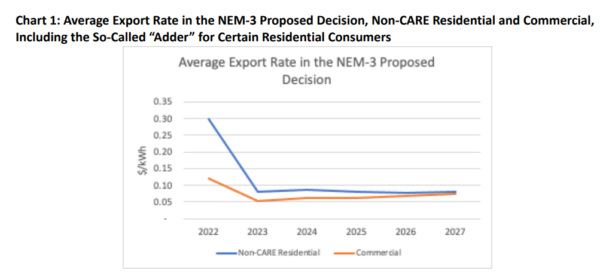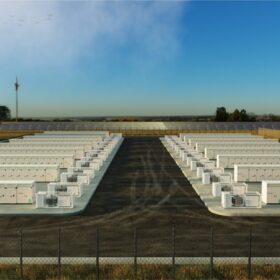The California Public Utilities Commission (CPUC) is expected to vote on the proposed Net Energy Metering (NEM) 3.0 in mid-December. The proposed decision changes the structure of net metering, and also lowers export rates by as much as 76%, a change that has been heavily criticized by the solar industry.
Net metering is a process by which utility companies pay rooftop solar owners for exporting electricity back to the grid. The solar array produces extra electricity during the day and in sunnier times of the year, so that a credit carries on the utility bill to cover the times when solar production is not covering electricity usage. Net metering helps rooftop solar owners get a return on their investment, and the excess energy sent by the system helps utilities balance the grid and meet demand.
Currently, average net metering rates range from $0.23 per kWh to $0.35 per kWh, and the new proposed decision cuts those rates to an average of $0.05 per kWh to $0.08 per kWh. This is set to be the largest drop in export rates in U.S. history, in a market that represents roughly 50% of the nation’s residential solar market.

Current NEM 1.0 and 2.0 customers are grandfathered in to their rates for 20 years, as are those who receive grid interconnection approval from the utility before 3.0 is enacted, should it go through in the vote. If enacted, the final date by which interconnection approval would be needed to attain NEM 2.0 rates would be April 15, 2023.
“If passed as is, the CPUC’s proposal would protect utility monopolies and boost their profits, while making solar less affordable and delaying the goal of 100 percent clean energy,” said Bernadette Del Chiaro, executive director of the California Solar and Storage Association (CALSSA).
There are several case studies across the nation that have shown solar adoption falls sharply following such a rulemaking decision. In California, the Imperial Irrigation District abandoned net metering in July 2016, causing residential solar installations to decline 88%. Also in 2016, Nevada made a cut to net metering compensation resulted in a 47% reduction in residential solar installations over the next year, said CALSSA. This led to a 2017 legislative session that restored net metering, which led to an increase in solar adoption.
“At a time when California needs rooftop solar to flourish, it’s risky to cut a key incentive without having a viable alternative in place. California’s decision-makers need to make rooftop solar as affordable and accessible as possible so that every household with solar potential can realistically make the choice to go solar,” said Laura Deehan, state director, Environment California.
The CPUC found that California must triple the amount of local, distributed solar to reach the clean energy mandate laid out by the state’s Senate Bill 100. CALSSA said rooftop solar will save California ratepayers $120 billion by 2050, or $300 per person per year.
Abigal Ross Hopper, president and CEO of the Solar Energy Industries Association (SEIA), said that the decision should be altered to “ensure a more gradual transition to net billing.”
With upcoming CPUC vote, there is still time to voice opinion on the rulemaking procedure. Visit savecaliforniasolar.org to learn more.
This content is protected by copyright and may not be reused. If you want to cooperate with us and would like to reuse some of our content, please contact: editors@pv-magazine.com.









“There are several case studies across the nation that have shown solar adoption falls sharply following such a rulemaking decision. ” And this is exactly why the corrupt individuals in the CPUC, who likely personally benefit from it in one way or another, will vote in favor of rule-making that helps to kill solar adoption. They’re not interested in the public good or in truly promoting clean, renewable energy sources.
It seems like the safer route that still meets goals would be to lower the export tariff gradually as utilities actually bring grid scale renewable generation online. That would best align incentives to meet goals. If there is so much renewable energy on the grid that rooftop solar becomes less valuable for new customers, so be it. It should drop. That’s the reality. But only as we see sufficient new clean generation.
What goals? More profits for the utilities? It’s interesting that the utilities like to build their own giant solar farms, but they don’t want individuals to make any energy by themselves. Monopolies never give up easily; this fight will rage across the country for years, only to end in the vastly superior paradigm of highly distributed generation and point-of-use, and with a national grid incorporating storage at many levels including EV batteries. We could get there much quicker if we were a wiser species with even a speck of regard for the common good.
@Doc SMith
“What goals?”
Environmental (net zero carbon) and affordability goals on an aggressive timeline.
Enough renewable generation on the grid to get to net zero.
That’s the bottom line. Not homeowners being able to sell electricity at a massively subsidized rate. And not utility profit margins.
How we get to net zero is less important to me than that we get there. We won’t get there if the renewable generation isn’t built, and we won’t get there if it’s not affordable to consumers to switch off of fossil fuels.
Yes, John, the fact that long before utilities even considered solar farms, rooftop solar enthusiasts were paying 8 dollars a watt to go green. Now that the price is under $3.00 per watt, utilities are going to make on-grid rooftop solar connections unaffordable, so, going off grid will make the home green, but the grid will have to find another way than keeping all that rooftop solar power for a discounted price. I would rather see rooftops and parking lots covered with solar, within my community, than good quality farmland or habitat 100 miles away from my town get prioritized by utilities. When rooftop solar uses the grid as their storage system, rather than a battery, the grid should be compensated in some way but not so expensive that the solar panels never get installed. Even a two for one split that let the consumer install more solar to build up enough credits at 2 for 1 to power through the winter would be fair but the 4 for 1 proposed with only a 35% increase in allowed solar would leave the consumers with hefty true up bills each year and little incentive to add the cost of batteries while on grid since batteries are only short-term storage.
Capitalism, free market, politics…we need to seriously rethink our way of life.
“What goals? More profits for the utilities? It’s interesting that the utilities like to build their own giant solar farms, but they don’t want individuals to make any energy by themselves. Monopolies never give up easily; this fight will rage across the country for years, only to end in the vastly superior paradigm of highly distributed generation and point-of-use, and with a national grid incorporating storage at many levels including EV batteries. We could get there much quicker if we were a wiser species with even a speck of regard for the common good.” . . .
I completely agree with you, Doc!
Public utilities with their monopoly status is far from Capitalism my friend.
Building an off-grid system with batteries is the next best thing to NEM 2.0 because the battery costs are less than the 75% rip-off from the utility. Hawaii, because of its small generation, could not connect new solar customers to its expensive grid so the new customers just went off-grid with their solar and still saved money plus had resiliency in systems that could weather any grid power failure. Just as cell phone TechKNOWLOGY has cut people loose from hard wired land lines, new solar TechKNOWLOGY will cut people away from the monopoly overpriced grid tied utilities and the fossil fuels that power them. Just tell the installer you want to be off grid with a “utility back up” in your system. Just buy what you need from the utility in the winder when rates are lower and power through the summers without even using any high-cost utility power.
I’ve heard utilities want to charge for a connection whether you use it or not. Or even to bill homeowners in their service areas if they go off-grid!
A standby fee and a transfer switch are all you need and that gives one access to the grid when the skies are cloudy all day.
this is not an option for the vast majority of Californians. most markets actually require you to have a hookup whether you use it or not. SDGE specifically does
James, you can stay connected to the grid using a grid/off-grid transfer switch like those used for backup generators. Keeping the utility as a backup power sourced or even just powering some circuits with it can still lower your bills without the actual solar panels being grid tied.
After all the death on their hands, that the CPUC feels entitled to do this is just so unreal.
CA should propose a PROPOSITION like we passed here in NV that guarantees long-term Net Metering for decades and is built into the state constitution. No more NEM policy revisions to fight over every year or two…it’s great having that stability.
That’s exactly what we should do here in California.
Im all for everyone to have a araie of panales on the roof how can the power com charge. A basic price plus for the power we use davehoward3562
I’m a fan of rooftop solar but have to admit there are zero other places where I can buy and sell any product at the same price. That addresses export rate but does not absolve the poorly run, porky IOU rates in Cali. Just compare their rates to the PBUs in Cali for a shock.
PGE vs SMUD or Santa Clara Electric is a simple comparison.
With the PG&E tiered system, they discount the energy exported by the homeowner to the lowest tier allowed in both low period and peak period times, but the homeowner bust buy it back at the higher tiers if they use more than 10 kilo watt hours that day. The end of year true up for any remaining energy credits generated by the homeowner are Zeroed out at just 3 cents per kilo watt hour even if they were worth 39 cents at the time of export to the grid. These are not a true 1 for 1 credit but more like a 1.25 for 1 after the utilities get through with their manipulation of rates. NEM 3.0 would make it a 4 for 1 credit and that in itself would kill any future investment in grid tied rooftop solar so the off-grid option becomes the best option. FYI the PG&E paper bill, I get every month, is 10 pages long with the kilo watt hours are converted monthly to dollars of cost or of credit and as electrical rates go up, the dollars are worth less for future buy backs of energy as well. In the summer months, I produce a lot of extra “Peak Time Power” that they literally get for free rather than pay the higher commodity pricing for that energy and at true up get to pau me only 3 cents. NEM 2.0 was already a profit maker for the utility, but they want MORE.
This is nothing more than the utilities demonizing an alternative source of power they don’t control. Utilities are taking power they don’t make, charging a customer for that power and crediting the homeowner with solar pennies on the dollar for it. This is mofia kicking in the door and taking money and demonizing the homeowner.
Outrageous!
Storm troopers kicked in my door last night looking for batteries under the floorboards. Or maybe I previsioned that.
Home battery storage is getting more affordable but they currently only last about 10 years..
Some higher end batteries are also smart/connected and capable of talking directly to the utility.
Utilities ought to work with home solar(with battery) installations to flatten its “duck curve” (around sunset hours) by pulling power from those batteries when they need it most? I’m sure they’ll even be willing to pay a premium over retail prices for such on-demand power draw. When will we see the utilities championing Smart Grid 2.0?
Prasanna, good question about Smart Grid 2.0!
I spent $2,400 to build a LiFePO4 14.3 KWh battery for my off-grid system. Even if it only lasts 8, rather than 10 years, it will still be a very good investment.
Doc Smith, “they don’t want individuals to make any energy by themselves”. NEM 3.0 doesn’t interfere with individuals making energy by themselves; you can make all you have the capacity to. All it does is stop requiring the utility to pay you for excess energy at a rate far higher than what it costs them to generate it or purchase it.
In a recent thread here on NEM 3.0, I presented a calculation of rentability that gave a 15 year payback period for the proposed NEM 3.0 ruling.
Unfortunately, I didn’t receive any reply.
The calculation was based oh the following assumptions:
8 kWp; 20,000 USD; 6000 USD tax credit, 1400 kWh per kWp and year, 20% on site consumption, retail tariff 30 ct per kWh with an annual increase of 2%, inflation rate 3%, discount rate 4%.
With these parameters, my program yielded 6.6% internal rate of return over 20 years which corresponds to a payback time of 15 years.
Can you do the calcs and give me feedback?
Btw: 25% of 30 ct/kWh are 7.5 ct/kWh. In Germany, with less solar yield, we were payed 8.2 ct/kWh from the utility until July 2022 for energy fed into the grid.
California and Hawaii are not good Rooftop PV (RPV) models for the rest of our country. Especially in northern climes where rates are higher due to weather and deregulation.
Moreover Rooftop Solar penetration is becoming dependent on “WHETHER” states will keep their non-solar taxpayer funded incentive solar kickbacks and NEM in place. Many states are looking at reducing both.
In states with lower e-rates and lower rooftop PV penetration, most households have bigger budget worries than electric bills.
Those with means or tree-hugging greenies may go for it, but not in significant numbers as large scale solar farms get built out, especially in southern states. “Let the utilities do it…” is the prevailing attitude for most who are too busy day to day to care.
Most think over-rated $olar doesn’t make economic sense in their AVERAGE household’s budget. Hence why they: 1) Don’t have it, 2) Can’t afford it or 3) Don’t need or want it.
They have higher priorities for their GreenBacks than going green. Besides, Electricity IS NOT the average household’s major expense after taxes.
The average household earned $87,432 in 2021 before taxes and spent $66,928, according to this BLS survey.
https://www.bankrate.com/banking/savings/average-household-budget/
Significant expenditures were housing, transportation and food. Slightly more than three-quarters of people’s income in 2021 was devoted to living expenses.
Average 2021 household earning and expenditure statistics:
=================
Household earnings $87,431
Total household expenditures $66,928
Housing expenditures $22,624
Transportation expenditures $10,961
Food expenditures $8,289
An overall increase in household expenditures from 2020 of 9.1%
Percent of people’s income devoted to living expenses 76.5%
Area of largest expenditure increase (decrease) Entertainment (22.7%)
…a reduction
Average monthly cost of utilities:
=======================
Electricity $117.46 ($1,410/yr) or just 2.1% of ANNUAL expenditures.
Natural gas $61.69
Water $45.44
Sewer $66.20
Trash $25-$100
=======================
Util SubTot: ~$315 to $390 per month
So why all the SOLAR FU$$?
Because the Fed is giving 30% kickbacks to 1% to 12% of the population with means to go solar, especially in states where rates are highest due to winter weather, power sources, fuels and deregulation.
Hence why solar doesn’t matter to most, especially those living paycheck to paycheck. A cutback on entertainment expenses, cheaper food and clothing brands handles higher electric rates or adjusting the thermostat.
Also: https://www.powermag.com/a-global-look-at-residential-solar-adoption-rates/
Think about it…
State Avg Elec Rates: Cents/kWh
Hawaii 39.97 1%RPV
California 26.71 12%RPV
Connecticut 25.61
Massachusetts 25.33
Rhode Island 23.46
Maine 23.03
New Hampshire 22.97
Alaska 22.82
Vermont 19.8
New York 19.74
Michigan 17.43
New Jersey 16.93
Wisconsin 15.2
Illinois 14.73
Pennsylvania 14.7
Indiana 14.29
Maryland 14.16
District of Columbia 14.04
South Carolina 13.91
Alabama 13.71
Colorado 13.61
Florida 13.5
New Mexico 13.44
Minnesota 13.4
Nevada 13.39
West Virginia 13.34
Kansas 13.32
Delaware 13.16
Georgia 12.89
Ohio 12.87
Texas 12.8
Arizona 12.68
Mississippi 12.66
Virginia 12.54
North Carolina 12.24
Kentucky 11.98
Iowa 11.73
Tennessee 11.49
South Dakota 11.35
Oklahoma 11.21
Louisiana 11.05
Missouri 11.04
Oregon 11.01
Arkansas 10.9
Montana 10.76
Wyoming 10.69
Utah 10.55
Nebraska 10.36
Washington 10.14
Idaho 10.07
North Dakota 10.03
https://www.statista.com/statistics/630090/states-with-the-average-electricity-price-for-the-residential-sector-in-the-us/
It’s interesting how the Conservatives are only interested in Conserving the status quo – i.e. dirty fossil-fuel drilling and burning in order to conserve their cash machine. Nevertheless, clean, renewable energy is winning. And it’s winning because of economics, and slowly but steadily, eroding the fossil-fuel industry’s choke-hold on people everywhere. To accelerate it faster, the government subsidies being given to the fossil-fuel industry should be stopped and given to clean, renewable energy R&D.
Net metering only serves to benefit the utility company and not the consumer. The price paid per KWR is less than 2 cents when you add in all factors. To limit exposure to companies like PG and E, turn off your main switch in the electrical box when producing more power than you are using; this way, you are not receiving or transmitting Power to the utility company.
Note this only works if you can or are producing excess power and or have your own backup storage/batteries.